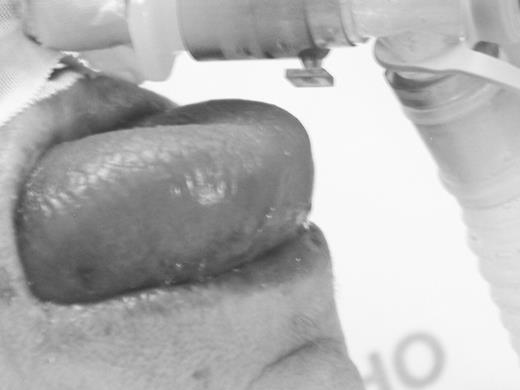Abstract
A Caucasian female, born in 1941, was first seen in November 2002 because of tiredness, weight loss and splenomegaly. She was taking glyburide, procylidine and venlafaxine for diabetes, parkinsonism and depression. Physical examination, revealed marked splenomegaly but no lymphadenopathy. Flowcytometry of peripheral blood showed a monoclonal B cell lymphoproliferative disorder consistent with marginal zone lymphoma. She was treated with chlorambucil 6 mg daily and prednisone 25 mg daily. She responded well to therapy. Chemotherapy was discontinued in December 2003. In April 2005 she was admitted to the hospital with pneumonia. She had pancytopenia and marked splenomegaly. Bone marrow apirate showed infiltration with marginal zone lymphoma cells. She was prescribed Chlorambucil 6 mg daily for management of her recurrent lymphoma. She took her first 6 mg of Chlorambucil at 8:00 PM of May 18, 2005 and woke up around 5:30 AM with grossly swollen tongue. She was brough to Emergency ward at 06:45 hr with grossly swollen, tender tongue protrudinng form her widely opened mouth. Angioedema of the tongue was diagnosed and she was given epinephrin, IV Benadryl, Solumedrol and morphine. By 10:00 hr, she was in moderate respiratory distress. She was taken to OR at 10:20 for urgent intubation or tracheotomy. Endoscopy revealed ++ oropharyngeal and supraglotic edema. A nasotracheal tube was inserted at 11:00 hr. The picture included was taken one hour after intubation.(16 hrs after taking chlorambucil). She was given Solumedrol 125 mg IV Q 12 hr. By 24 hours after intubation her tongue had receded into her mouth and she was extubated. Her serum C1 inhibitor was 0.13 g/L (normal 0.15–0.35) and functional C1 esterase inhibitor was 87% (normal >67%). Immunoglobulines, C3 & C4 were normal. Her lymphoma was treated with 6 courses of R-CVP regimen. She has not received any more chlorambucil and she has not had any more angioedema or anaphylactic reaction of any kind. In May 2005 her C1 inhibitor was 0.38 g/L and functional C1 esterase inhibitor was 96%.
Discussion: on the day before experiencing angioedema of the tongue, she had not taken any unusual food or any other new medication. The time sequence and subsequent course of this case strongly suggest that the angioedema of the tongue was due to Chlorambucil. The literature does not show any report of chlorambucil induced angioedema. However, angioedema is listed as one of the adverse reactions of Chlorambuci both in AHFS Drug Information and in Compendium of Pharmaceuticals and Specialities. Following communication with GlaskoSmithKline, the manufacturer of Chlorambucil, I was told that, they are not aware of any published report, but they have reports of angioedema induced by Chlorambucil in their file. I was told that they are not in position to reveal the number of such reactions.
Disclosure: No relevant conflicts of interest to declare.


This feature is available to Subscribers Only
Sign In or Create an Account Close Modal